Abstract
This study investigated the relationships between internal and external training load metrics across a 2-week ‘in-season’ microcycle in squash. 134 on-court and 32 off-court ‘conditioning’ sessions were completed by fifteen elite squash players with an average (±SD) of 11 ± 3 per player. During every session, external load was captured using a tri-axial accelerometer to calculate Playerload; i.e., the instantaneous rate of change of acceleration across 3-dimensional planes. Internal load was measured using heart rate (HR), global (sRPE) and differential RPE (dRPE-Legs, dRPE-Breathing). Additionally, HR was used to calculate Banister’s, Edward’s and TEAM TRIMPs. Across 166 training sessions, Playerload was moderately correlated with TRIMP-Banister (r = 0.43 [95% CI: 0.29-0.55], p < 0.001) and TRIMP-Edwards (r = 0.50 [0.37-0.61], p < 0.001). Association of Playerload with TRIMP-TEAM (r = 0.24 [0.09-0.38], p = 0.001) was small. There was a moderate correlation between sRPE and Playerload (r = 0.46 [0.33-0.57], p < 0.001). Association of sRPE was large with TRIMP-Banister (r = 0.68 [0.59-0.76], p = 0.001), very large with TRIMP-Edwards (r = 0.79 [0.72-0.84], p < 0.001) and moderate with TRIMP-TEAM (r = 0.44 [0.31-0.56], p < 0.001). Both dRPE-Legs (r = 0.95 [0.93-0.96], p < 0.001) and dRPE-Breathing (r = 0.92 [0.89-0.94], p < 0.001) demonstrated nearly perfect correlations with sRPE and with each other (r = 0.91 [0.88-0.93], p < 0.001). Collection of both internal and external training load data is recommended to fully appreciate the physical demands of squash training. During a training microcycle containing a variety of training sessions, interpreting internal or external metrics in isolation may underestimate or overestimate the training stress a player is experiencing.
Key points.
In elite squash, little agreement was observed between HR-based, internal load metrics and the accelerometer-derived, external metric Playerload during a 2-week training microcycle.
Across a squash training microcycle, interpreting internal or external loads in isolation, may underestimate or overestimate training load.
Differential RPE training loads did not reveal stronger relationships with other metrics than sRPE-TL alone, which may be appropriate surrogate for HR monitoring across a squash microcycle.
Key words: Squash, training load, accelerometry, RPE, heart rate
Introduction
Monitoring training load is a priority for coaches and sport science/medicine practitioners who balance a quest for optimal physical adaptation with the potential for overtraining and/or injury risk. Training load monitoring is well established in team sports, including football (Impellizzeri et al., 2005; Akubat et al., 2012), rugby (McLaren et al., 2018) and Australian Rules Football (Boyd et al., 2013). Although highlighted as a research priority within tennis (Vescovi, 2017), limited literature has monitored load experienced by racquet sports’ players. As with many racquet sports, squash elicits considerable metabolic and muscular demands (James et al., 2021). Indeed, players undertake repeated high-intensity changes of direction within a small area (Jones et al., 2018), with additional contributions from upper body activity during shot playing (Fernandez-Fernandez et al., 2010). These characteristics, allied with an intermittent activity profile, present a challenge for support staff in identifying the most appropriate method of monitoring training load in squash.
Squash elicits the greatest physical demands of all racquet sports (Girard and Millet, 2009), with the longest rallies (~15-20 s) and smallest work:rest ratios (1:1) (Girard and Millet, 2009; Jones et al., 2018), which results in a mean match intensity of 86% of V̇O2max at elite level (Girard et al., 2007). Consequently, elite squash players undertake a high volume of physical training, encompassing specific on-court training such as ‘group’ or ‘feeding’/’pressure’ sessions, that simulate match-play scenarios, whilst allowing greater control of the physical stimulus (James et al., 2021; Gibson et al., 2019). Within a typical training microcycle, players may also undertake ‘ghosting’ sessions, involving repeated simulated shots and movement patterns, in addition to off-court strength and conditioning training (Bennie and Hrysomallis, 2005). However, the most appropriate methods of monitoring cardiovascular and musculoskeletal demands across this variety of training methods remains unknown, hindering practitioner’s ability to interpret and adjust physical loads across a microcycle.
Across many sports, including squash, heart rate (HR) monitoring is the ubiquitous approach to quantifying internal load (Gibson et al., 2019). HR data may be aggregated into a training impulse (TRIMP) metric, whereby a weighting is applied in accordance with physiological strain, derived from a prior HR:blood lactate curve (Banister, 1991; Edwards, 1993; Stagno et al., 2007; Akubat et al., 2012). Recent TRIMP calculations advocate assigning weightings from population-specific HR:blood lactate relationships, and these approaches demonstrate dose-response relationships with fitness improvements over a training period (Stagno et al., 2007; Akubat et al., 2012). Indeed, methods of training load monitoring should reveal such a dose-response relationship to demonstrate convergent construct validity (Manzi et al., 2009). However, the agreement between exercising HR and oxygen consumption is reduced by fluctuations in exercise intensity, especially above the second ventilatory threshold, which squash players regularly exceed (Girard et al., 2007). This weakens confidence in utilising HR to fully represent the demands of training within intermittent activities such as squash or other racquet sports (Fernandez et al., 2006).
External training load represents the physical training completed during a session and is typically expressed as running distance (total or differentiated by velocity) and may include total accumulated high-intensity movements (Impellizzeri et al., 2005). Consequently, the instantaneous nature of external load measurement through wearable accelerometers becomes advantageous for quantifying short duration, high-intensity accelerations or decelerations. Many wearable technology companies now offer a metric that represents the global stresses placed upon the musculoskeletal system outside the scope of velocity/distance, by aggregating 3-dimensional (3D) accelerometer data. These algorithm-derived metrics may therefore capture multidirectional squash-specific demands, such as repeated accelerations, decelerations, lunges and potentially the upper body work associated with shot playing. Whilst upper body actions from shot playing elicits additional physiological strain to that from locomotive movement demands (Fernandez-Fernandez et al., 2010), the sensitivity of a vest-worn accelerometer to detect these actions has yet to be ascertained. Nevertheless, whilst global metrics such as Playerload (Catapult Sports, Melbourne, Australia) have been used to quantify external load in tennis (Gescheit et al., 2015) and badminton (Abdullahi et al., 2019; Wylde et al., 2019), they have yet to be used in squash. It is therefore unknown if external metrics demonstrate agreement with internal load measurements in squash.
Compared with HR monitoring and wearable technology, multiplying the session rating of perceived exertion (sRPE) by the training duration offers an affordable, time-efficient and holistic measure of training load (sRPE-TL), which has been used in tennis (Murphy et al., 2015; Vescovi, 2017). Internal training load encompasses an individual’s psychophysiological responses to exercise and thus includes perceptual responses such as RPE (Impellizzeri et al., 2005). The sRPE represents an integration of a range of inputs including, but not limited to, working muscles, cardiovascular and pulmonary systems, joints, sweating, possible pain and dizziness (Borg et al., 2010). Whilst sRPE-TL is a valid measure of training load across a variety of training modalities (Scott et al., 2013b), sRPE lacks sensitivity in differentiating the specific demands players experience during training (McLaren et al., 2016). Differential RPE (dRPE) helps overcome this issue, taking specific exertion responses for the active muscles and breathing, to provide more actionable information into the source from which the subjective perception of exertion is determined (Arcos et al., 2014; Weston et al., 2015; McLaren et al., 2016). Previous research advocates utilising dRPE during exercise aligned with endurance (Borg et al., 2010; McLaren et al., 2016) and team sports (Arcos et al., 2014; Weston et al., 2015). However, whether dRPE-TL demonstrates agreement and therefore serves as a suitable proxy for internal or external load in squash is unknown.
Therefore, the primary aim of this study was to investigate the relationships between training load monitoring approaches in international squash players, during a 2-week ‘in-season’ microcycle. It was hypothesized that internal and external training load approaches would demonstrate little agreement when analysed across a training block however, there would be agreement within internal metrics. A secondary aim was the novel reporting of high-intensity movements in squash measured using wearable technology. We hypothesised a comparable number of accelerations and decelerations, as well as changes of direction to the left as to the right, across the training block.
Methods
Subjects
Fifteen professional Malaysian squash players (11 males, 4 females) volunteered for this study (age: 19.1 ± 2.5 years, playing side: 14 right-handed and 1 left-handed). All players typically completed ten training sessions per week (~11 hours). They had been taking part in the national program for at least 2 years and regularly competed internationally in Professional Squash Association (PSA) events. A typical training week may comprise three ‘group’ on-court training sessions, one/two match-play sessions, one/two individual coaching ‘feeding’ sessions, two strength sessions and two/three conditioning sessions (outdoor running or on-court, audio-based ‘ghosting’). Players provided written, informed consent and the study received institutional ethical approval, conforming to the Declaration of Helsinki.
Design
Across a 2-week (in-season) microcycle, training data were collected from players at the National Squash Centre of Malaysia. During every training session, data were obtained using a tri-axial accelerometer embedded within a GPS unit, HR monitor and RPE, pertaining to global (sRPE) and differential RPE (dRPE). Strength training sessions were not included in the study. All players had completed an incremental squash-specific aerobic fitness test (James et al., 2019), within three months of the training block, to derive blood lactate and HR relationships for the calculation of TRIMP metrics.
Training load measures: External load - Playerload
Players wore a 100 Hz accelerometer/GPS unit (G5, Catapult Sports, Melbourne, Australia) harnessed between the scapulae in a customised sports vest, with a paired, chest-worn HR monitor (Polar T31-coded, Kempele, Finland). All players had worn the vest previously and used the same devices throughout every session, starting before the warm-up until completion of the warm-down. Accelerometer data were downloaded with associated software (Openfield, Catapult Sports, Melbourne, Australia). Activities were cropped to include training data and rest periods but exclude warm-ups and cool-downs. Session duration was derived from Openfield software, with this duration used across all external and internal metrics where duration contributed to the calculation.
External load – High-intensity movements
Accelerations, decelerations and left/right changes of direction were detected using Inertial Movement Analysis (IMA version 2, Catapult Sports) (Catapult sports, 2019). Movements that exceeded 2.5 m.s-2 and 3.5 m.s-2 were recorded as high-intensity (HI) and very high-intensity (VHI) events, respectively (Harper et al., 2019). Movements <2.5 m.s-2 were excluded. The sum of all VHI movements was combined into a single measure of multidirectional high-intensity load (Total VHI) (Luteberget et al., 2018).
Internal load - TRIMP
HR data were processed as per PlayerLoad. The following TRIMP calculations were made in custom-made spreadsheets: ‘Banister’s TRIMP’ (TRIMP-B) (Banister, 1991), ‘Edward’s TRIMP’ (TRIMP-E) (Edwards, 1993) and ‘Team TRIMP’ (TRIMP-TEAM) (Akubat et al., 2012).
TRIMP-B utilises the mean exercising HR through the following formula:
| TRIMP = D(ΔHR ratio)eb((ΔHR ratio) |
where D is the duration of training session is 1.67 for females and 1.92 for males and ΔHR ratio equals HRexercise-HRrest/HRmax-HRrest.
TRIMP-E was calculated by multiplying the duration spent in each HR zone (50-60%, 60-70%, 70-80%, 80–90%, and 90-100% HRmax) by the weighing factor allocated to each zone (1 = 50-60%, 2 = 60-70%, 3 = 70-80%, 4 = 80-90%, and 5 = 90-100%) and summating the results (Edwards, 1993).
TRIMP-TEAM was calculated in accordance with Akubat et al. (2012), using pooled incremental test data to generate a group exponential curve and formula of the HR:blood lactate relationship. To utilise all training data, a TRIMP value was calculated for every HR reading. Due to differences in physiological responses to squash-specific exercise and continuous treadmill running (Girard et al., 2005), the HR:blood lactate relationship was derived from an incremental squash-specific aerobic fitness test (James et al., 2019), in accordance with the recommendation for test specificity within intermittent sports (Akubat and Abt, 2011). HRmax was the highest value observed during any fitness test, training or match in the past 12 months.
Internal load – RPE
Fifteen minutes after each session, sRPE, as well as differentiated ratings of exertion for active muscles (dRPE-legs) and the chest/breathing (dRPE-breathing) were recorded on a printed, training diary sheet. Following familiarisation, sRPE data were collected using the CR100 Centimax scale (Borg and Borg, 2002), which provides increased precision for monitoring training intensity over the CR10 scale (Scott et al., 2013b). Players were instructed to use the descriptive terms on the CR100 scale to indicate the intensity of the session (with regard to their ‘whole-body’ [sRPE], ‘legs’ [dRPE-legs] and ‘breathing’ [dRPE-breathing]) and write down the corresponding number. Players selected numbers between descriptors, where they felt the answer lay between two descriptive terms (Borg and Borg, 2002). All RPE responses (sRPE, dRPE-legs and dRPE-breathing) were multiplied by the session duration, to provide three separate measures of training load.
Statistical analyses
Data are presented as mean ± SD. Data were assessed for normality of distribution using histograms, boxplots and measures of skewness and kurtosis, prior to analysis. Relationships between training load metrics were analysed using Pearson product–moment correlations, with 95% confidence intervals calculated around the correlation coefficient (r), using a custom Microsoft Excel (Microsoft Inc., Washington, USA) spreadsheet (Hopkins, 2006). Interpretation of the correlation coefficients was evaluated qualitatively as: 0-0.09, trivial; 0.1-0.29, small; 0.3-0.49, moderate; 0.50-0.69, large; 0.70-0.89, very large; 0.90-0.99, nearly perfect; 1.00, perfect (Hopkins et al., 2009). Due to the absence of a normal distribution of data, differences between high-intensity movements were investigated using Friedman’s ANOVA, with Wilkcoxon Signed Rank test post hoc (Bonferroni correction). The effect size (ES) R, was calculated in accordance with Rosenthal (1991) and these data were analysed using SPSS (Version 25, IBM Inc, USA).
Results
A total of 166 training sessions were recorded (mean 11.1 ± 3.1 per player), with a mean duration of 54.7 ± 21.8 minutes. The microcycle comprised a total of 21 Feeding, 16 Ghosting, 53 Group, 44 Match-play and 32 Running Conditioning sessions. Five sessions revealed erroneous HR data containing only zero values and were excluded from final analysis.
The mean HR of training sessions was 78 ± 6% of individual HRmax. Mean internal training load values were 87 ± 38, 178 ± 70 and 1011 ± 677 a.u. for TRIMP-B, TRIMP-E and TRIMP-TEAM, respectively. The mean sRPE score was 71 ± 18 (or ‘very strong’). The mean sRPE-TL was 3903 ± 1848 a.u. The mean Playerload was 388 ± 143 a.u.
The relationships between internal and external training load metrics are shown in Table 1 and Figure 1. Playerload was moderately correlated with internal load metrics TRIMP-B and TRIMP-E, whilst revealing a small correlation with TRIMP-TEAM. Playerload also demonstrated moderate relationships with sRPE-TL and dRPE-TL derivatives. Total VHI revealed moderate-large correlations with all metrics, apart from Playerload, which was small. There were large-to-very large correlations between both TRIMP-E and TRIMP-B and all sRPE-TL and dRPE-TL derivatives. However, sRPE-TL and dRPE-TL only revealed moderate correlations with TRIMP-TEAM. The mean TRIMP-TEAM, Playerload and sRPE-TL training loads across the microcycle are shown in Figure 2.
Table 1.
Relationships (Pearson’s correlation coefficient [r] and 95% confidence intervals) between internal and external training load metrics.
| Session duration | TRIMP Banister | TRIMP Edwards | TRIMP-TEAM | PlayerLoad | sRPE | dRPE-Breathing | dRPE-Legs | |
|---|---|---|---|---|---|---|---|---|
| TRIMP Banister | 0.72* [0.64-0.79] |
- | ||||||
| TRIMP Edwards | 0.86* [0.81-0.9] |
0.95* [0.93-0.96] |
- | |||||
| TRIMP-TEAM | 0.39* [0.25-0.51] |
0.74* [0.66-0.8] |
0.65* [0.55-0.73] |
- | ||||
| PlayerLoad | 0.47* [0.34-0.58] |
0.43* [0.29-0.55] |
0.50* [0.37-0.61] |
0.26* [0.11-0.4] |
- | |||
| sRPE | 0.82* [0.76-0.86] |
0.68* [0.59-0.76] |
0.79* [0.72-0.84] |
0.44* [0.31-0.56] |
0.46* [0.33-0.57] |
- | ||
| dRPE-Breathing | 0.77* [0.7-0.83] |
0.60* [0.49-0.69] |
0.71* [0.62-0.78] |
0.35* [0.21-0.48] |
0.46* [0.33-0.57] |
0.92* [0.89-0.94] |
- | |
| dRPE-Legs | 0.83* [0.78-0.87] |
0.69* [0.6-0.76] |
0.78* [0.71-0.83] |
0.44* [0.31-0.56] |
0.48* [0.35-0.59] |
0.95* [0.93-0.96] |
0.91* [0.88-0.93] |
- |
| Total VHI | 0.66* [0.56-0.74] |
0.58* [0.47-0.68] |
0.64* [0.55-0.73] |
0.35* [0.21-0.48] |
0.11 [-0.04-0.26] |
0.50* [0.37-0.6] |
0.43* [0.3-0.55] |
0.51* [0.39-0.62] |
Data are drawn from all sessions during the training microcycle. Total VHI = combined accelerations, decelerations and left/right turns >3.5 m.s-2 during a given session. Data derived from inertial movement analysis (IMA Version 2, Catapult Sports).
* represents statistical significance (p < 0.05). Interpretation of the correlation coefficients; 0-0.09 trivial, 0.1-0.29 small, 0.3-0.49 moderate, 0.50-0.69 large, 0.70-0.89 very large, 0.90–0.99 nearly perfect and 1.00 perfect (Hopkins et al., 2009). sRPE, dRPE-Breathing and dRPE-Legs all represent the training load calculated from the respective raw RPE values, multiplied by the session duration.
Figure 1.
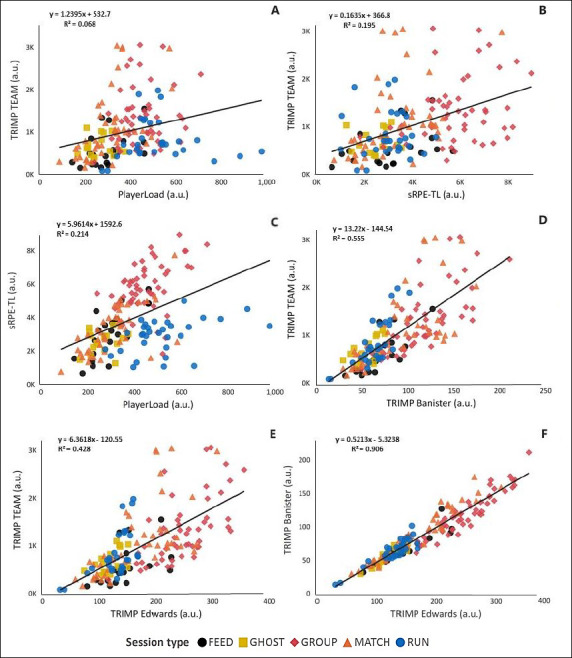
Agreement between primary internal and external training load metrics over the 2-week training period. All axes represent loads in arbitrary units. FEED = Coach Feeding session, GHOST = audio-based Ghosting session, CON = running Conditioning session. sRPE-TL represents the training load calculated from the sRPE multiplied by the session duration.
Figure 2.
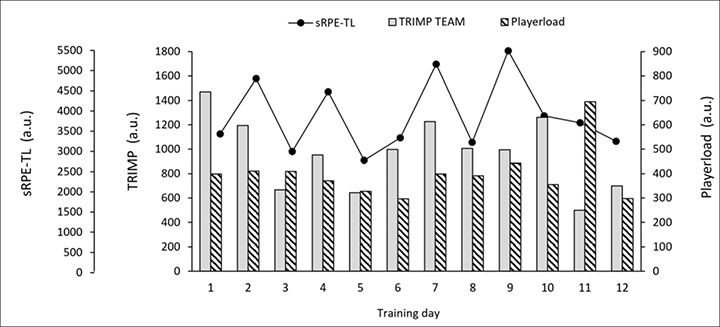
Longitudinal training loads across the microcycle training load derived from TRIMP TEAM, Playerload and sRPE-TL (sRPE multiplied by session duration).
Training loads derived from dRPE-legs and dRPE-breathing demonstrated nearly perfect correlations with sRPE-TL (Figure 3) but dRPE-breathing revealed a range of correlations with HR-based internal metrics (Table 1). There was a moderate correlation between the training load from dRPE-breathing with TRIMP-TEAM, a large correlation with TRIMP-B and a very large correlation with TRIMP-E. Training load from dRPE-legs demonstrated a moderate correlation with Playerload. Within dRPE-TL metrics, dRPE-legs and dRPE-breathing demonstrated a nearly perfect correlation (Figure 3).
Figure 3.
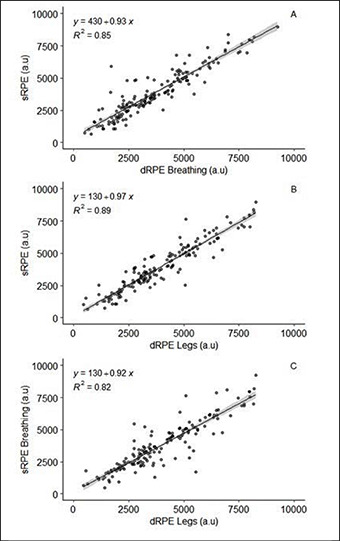
Agreement between session RPE (sRPE) and differentiated RPE (dRPE) for breathing (A), sRPE and dRPE for legs (B) and between dRPE-breathing and dRPE-legs (C). Data from all training sessions are plotted. Data were collected using CR100 scale. sRPE, dRPE-Breathing and dRPE-Legs all represent the training load calculated from the respective raw RPE values multiplied by the session duration. Shaded area around trendline represent 95% confidence intervals.
There were more HI (>2.5 m.s-2) accelerations (831 ± 383 per player) than decelerations (609 ± 350 per player) across the training microcycle (p < 0.001, ES R = 0.31). Similarly, VHI (>3.5 m.s-2) accelerations (479 ± 262 per player) were more frequent than VHI decelerations (193 ± 130 per player, p < 0.001, ES R = 0.50). There were more changes of direction to the left than right for both HI (left: 1451 ± 523, right: 414 ± 452, p < 0.001, ES R = 0.60) and VHI (left: 573 ± 255, right: 129 ± 230, p < 0.001, ES R = 0.57).
Discussion
This study investigated the relationships between internal and external training load approaches during a 2 week ‘in-season’ training microcycle. For our primary aim, we observed small-to-moderate agreement (r = 0.23-0.50) between internal (HR-based) and external (accelerometer-derived, Playerload) loads. Comparatively, sRPE-TL revealed stronger relationships with TRIMP calculations (r = 0.41-0.79), but similarly weak agreement with Playerload (r = 0.41). We also observed that relationships derived from legs/breathing dRPE-TL were highly agreeable with sRPE-TL (r = 0.92-0.95). This indicates these measures may not reveal additional, actionable information, compared with utilising sRPE-TL alone within a squash training period. In accordance with our hypothesis, the poor agreement between Playerload and TRIMP calculations indicate these measurements capture different demands of training in squash. For our secondary aim, we report a larger number of VHI accelerations than decelerations, as well as more frequent changes of direction to the left, rather than the right, across the microcycle.
Playerload
Some divergence between HR derived metrics and Playerload was expected, given the delay in HR response to short, intermittent, high-intensity movements occurring in racquet sports (Fernandez et al., 2006). These data support the overall trivial relationships that have been identified in badminton matches, between HR and Playerload (Abdullahi et al., 2019). However, in badminton, improved agreement (r = 0.44) has been found when only HR and Playerload data from predefined high-intensity zones were used, as opposed to all training data. The authors concluded the strength of the relationships were dependent on the duration of activities performed in low and high-intensity zones. In the current study, data are not drawn solely from matches, nor differentiated by intensity zones, but represent all on- and off-court training during the microcycle. We have previously shown different sessions within a squash microcycle to elicit specific physical demands (James et al., 2021). However, for our current analysis, we combined all sessions, to provide a ‘weekly’ view of training load, as required by a practitioner. Due to the variety of sessions and activity profiles within our dataset, this real-world perspective may exacerbate differences between internal and external metrics. In particular, measurements derived from a given training session may be influenced by different intended technical or physiological objectives, such as high duration, low intensity conditioning sessions (‘run’) producing high Playerload values, with low corresponding TRIMP scores (Figure 1A). Similarly, some high-intensity, but short duration matches and group sessions, resulted in high TRIMP values, again with low Playerloads (Figure 1A). Session structure has previously been highlighted as a factor influencing the relationship between training load metrics (Scott et al., 2013a), as the duration of rest periods will partly determine internal stress for a given external load. Therefore, practitioners should be aware of the potential for under- or over-estimating training load if utilising only TRIMP or Playerload metrics across a training week which contains a variety of sessions.
External load measurements such as Playerload benefit from independence of environmental factors such as temperature (James et al., 2017) and altitude (Turner et al., 2014) that may bias HR. However, it is unclear if the device location (between scapulae) accurately quantifies upper body work associated with shot playing, which hinders the interpretation of the poor agreement we observed between Playerload and internal loads. A further limitation of interpreting Playerload within this squash microcycle is the influence of accelerations measured from vertical motion (z-axis) within the algorithm. Playerload displays a nearly perfect correlation with total distance in team sports (Scott et al., 2013a; Boyd et al., 2013). During the squash sessions we analysed however, there were multiple changes of direction with repeated accelerations and lunges that drive up HR (Gibson et al., 2019). As a result, it is unclear if Playerload is sensitive in detecting these squash-specific demands across the training microcycle. Future research should therefore investigate how shot playing may influence Playerload.
TRIMP
Overall, TRIMP calculations and Playerload demonstrated poor agreement, yet agreement with Playerload varied between TRIMP calculations. The weakest relationship was between Playerload and TRIMP-TEAM. This TRIMP calculation appears best-supported within the literature, as it demonstrates convergence validity with changes in aerobic fitness across a training block (Stagno et al., 2007; Akubat et al., 2012). Unlike TRIMP-B and TRIMP-E, TRIMP-TEAM is underpinned by the exponential HR:blood lactate relationship of these specific players, derived from a squash-specific aerobic fitness test (James et al., 2019). Therefore, the weightings ascribed to the HR data are likely to provide a more representative indication of physiological strain during squash, compared with weightings derived from a continuous treadmill test (Akubat and Abt, 2011). Furthermore, TRIMP-TEAM does not categorise HR data into training zones. This approach would have resulted in values around zone boundaries being assigned different weightings and may not be representative of the progressive nature of changes in exercise intensity (Akubat et al., 2012). Consequently, whilst TRIMP-TEAM demonstrated large correlations with TRIMP-B and TRIMP-E, there was divergence during sessions of higher exercise intensity (Figure 1D, 1E). This may reflect the linear, rather than exponential, weightings assigned using TRIMP-E or because TRIMP-B uses only the mean HR and thus, is less sensitive to fluctuations in exercise intensity. Whilst previous literature indicates TRIMP-TEAM to be more accurate in quantifying the training dose-response relationship than TRIMP-B and TRIMP-E (Stagno et al., 2007; Akubat et al., 2012), we caution that studies have yet to be conducted within racquet sports demonstrating convergence validity with changes in physical fitness.
Session RPE
In light of the divergent findings between HR and Playerload, the potential utility of a ‘global’ indicator of the psychophysiological response to training stress, such as sRPE is apparent. Indeed, sRPE-TL is now being utilised in both tennis (Murphy et al., 2015; Vescovi, 2017) and squash (Gibson et al., 2019). Session RPE-TL demonstrated strong correlations with TRIMP-B (r = 0.68) and TRIMP-E (r = 0.79) and a moderate correlation with TRIMP-TEAM (r = 0.44). Therefore, these relationships support the notion that, when measured using the CR100 scale, sRPE-TL can provide useful information as a surrogate for HR metrics during squash training (Gibson et al., 2019).
The sRPE may also be sensitive to neuromuscular fatigue arising from external demands such as repeated isometric and eccentric muscle actions during lunging and shot playing, which contribute to lower-body neuromuscular fatigue in squash (Girard et al., 2010). Such sport-specific movements have been suggested as an explanation for elevated RPE without concomitant HR load during soccer training (Impellizzeri et al., 2004). However, sRPE-TL demonstrated only modest agreement (r = 0.46) with Playerload, reaffirming that internal and external metrics are quantifying different training demands.
Differential RPE
Theoretically, dRPE provides more specific information than sRPE, and may be associated with internal (dRPE-Breathing) and external (dRPE-Legs) loads (Arcos et al., 2014; Weston et al., 2015; McLaren et al., 2016). However, training load calculated from dRPE-Legs revealed a moderate (r = 0.48) correlation with Playerload, similar to that of sRPE-TL. In badminton, splitting Playerload into constituent parts (i.e. vertical, horizontal, frontal planes) does not reveal stronger relationships with dRPE-Legs (Wylde et al., 2019). Thus, within squash, it appears dRPE-Legs does not provide additional information to sRPE.
We observed strong relationships between the training load calculated from dRPE-Breathing with TRIMP-E (r = 0.71) and TRIMP-B (r = 0.60), alongside a moderate relationship with TRIMP-TEAM (r = 0.35). These relationships were consistently weaker than sRPE-TL revealed with the same TRIMP metrics, indicating a dissociation between an elevated HR and a sensation of breathlessness during squash training. This may indicate a limitation of utilising dRPE-Breathing in sports containing considerable fatiguing upper body work (i.e. shot playing).
High-intensity movements
Total VHI is a high-intensity external load metric that demonstrated moderate-large relationships with internal metrics, but only a small correlation with Playerload. The total number of high-intensity movements undertaken during a squash training period therefore represents a separate training demand to that quantified by Playerload. This relationship appears weakest during ‘conditioning’ sessions (Figure 1), which are characterised by a high Playerload and low number of VHI movements (James et al., 2021). Nevertheless, the monitoring of VHI movements appears pertinent, given a likely association with neuromuscular fatigue in squash (Girard et al., 2010) and predictive ability of muscle damage (Gastin et al., 2019).
For our second aim, we observed greater accelerations than decelerations, when classified both as HI (>2.5 m.s-2) or VHI (>3.5 m.s-2) events. We also observed a disparity between left and right changes of direction, with left turns more frequent. This may reflect a preference for lunging off the stronger leg within our predominantly right-handed cohort. This finding may also be influenced by the specific drills completed during this training period (e.g. backhand drills). However, as trunk orientation influences the classification of changes of direction, these preliminary data should be interpreted with caution, given the variable accuracy reported for class changes of direction (2-18%) identified using IMA, without the added complexity of racquet strokes (Luteberget et al., 2018; Catapult sports, 2019). It is unclear whether racquet strokes may influence the classification of changes of direction, therefore future research should investigate the accuracy of identifying these squash-specific movements in isolation. Nevertheless, these novel observations indicate training programmes should prepare players for repeated accelerations >3.5 m.s-2 and for right-handed players, potentially a greater proportion of changes of direction to the left.
Practical applications
The collection of both internal and external training load data in squash appears advantageous to understand the training stress and optimise physical preparation. Interpreting internal or external loads in isolation, following a variety of training sessions, may either underestimate or overestimate training load. Some TRIMP calculations have shown dose-response relationships with fitness improvements (Stagno et al., 2007; Akubat et al., 2012). Therefore, monitoring of internal training load using approaches that are derived from HR:blood lactate relationships may improve individual training prescription. However, we caution that our data were derived from fitness tests performed within 3 months of the study and therefore may be susceptible to changes in fitness during within this period. Moreover, dose-response relationships have yet to be reported using TRIMP during squash training and subsequent changes in fitness, using squash-specific testing protocols. Whilst external metrics cannot be used to assume improvements in fitness from training loads, the measurement of external load remains pertinent for quantifying mechanical load on the musculoskeletal system, which may be considered an injury risk factor.
Session RPE is not liable to data errors from HR or and does not require processing time associated with wearable accelerometer technology. The agreement we observed between sRPE-TL and TRIMP metrics indicates sRPE-TL is an effective surrogate for HR metrics during squash training, so provides a low-cost and time-efficient monitoring strategy.
Conclusion
In elite squash, little agreement was observed between HR-based, internal load metrics and the accelerometer-derived, external metric Playerload during a 2-week training microcycle. Differential RPE training loads did not reveal stronger relationships with other metrics than sRPE-TL alone, which may be appropriate surrogate for HR monitoring across a squash microcycle. Future research should investigate relationships of training load metrics with changes in squash-specific fitness to identify dose-response relationships and inform the most appropriate metrics to monitor.
Acknowledgements
The authors have no conflicts of interests to declare. The experiments comply with the current laws of the country in which they were performed.
Biographies

Carl JAMES
Employment
Senior Physiologist at the National Sports Institute of Malaysia (Institut Sukan Negara).
Degree
PhD, MSc, BSc
Research interests
Physiology and training of endurance, team & racket sports. Performance in hot and humid conditions.
E-mail: carlalexanderjames@gmail.com
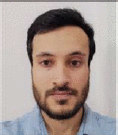
Aishwar DHAWAN
Employment
Senior Consultant Performance | Data Science, EDGE10 Group.
Degree
PhD, MSc, BTech
Research interests
Inter-intra individual variability from dynamical systems viewpoint, information classification, wearable technologies in sport.
E-mail: dhawanaishwar@gmail.com

Timothy JONES
Employment
Performance Scientist at the National Sports Institute of Malaysia (Institut Sukan Negara).
Degree
PhD, MSc, BSc.
Research interests
Include racquet sports, training monitoring, sports-specific profiling/interventions.
E-mail: tjjonah@yahoo.co.uk

Christopher POK
Employment
Institut Sukan Negara (National Sports Institute) Bukit Jalil Sport City, Kuala Lumpur, Malaysia
Degree
BSc (Hons)
Research interests
Physical performance in combat sports (Karate, Boxing) and racquet sports.
E-mail: pokyh91@gmail.com
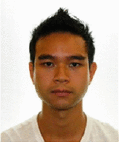
Vincent YEO
Employment
Catapult Sports, Victoria, Australia / School of Sports, Health and Leisure, Republic Polytechnic, Singapore.
Degree
MSc, BSc
Research interests
Eccentric Loading, Load Monitoring in Team Sports, GPS, muscle damage.
E-mail: vince.yeo87@gmail.com

Olivier GIRARD
Employment
Associate Professor in Human Performance at The University of Western Australia (Perth, Australia).
Degree
PhD
Research interests
Fatigue mechanisms during high-intensity intermittent exercises performed under challenging environmental conditions (i.e. heat stress or hypoxia), with a special focus on (repeated) sprinting mechanics and underpinning neuromuscular factors.
E-mail: olivier.girard@uwa.edu.au
References
- Abdullahi Y., Coetzee B., van den Berg L. (2019) Relationships between Results of an Internal and External Match Load Determining Method in Male, Singles Badminton Players. Journal of Strength and Conditioning Research 33(4), 1111-1118. [DOI] [PubMed] [Google Scholar]
- Akubat I., Abt G. (2011) Intermittent exercise alters the heart rate - blood lactate relationship used for calculating the training impulse (TRIMP) in team sport players. Journal of Science and Medicine in Sport 14(3), 249-253. [DOI] [PubMed] [Google Scholar]
- Akubat I., Patel E., Barrett S., Abt G. (2012) Methods of monitoring the training and match load and their relationship to changes in fitness in professional youth soccer players. Journal of Sports Sciences 30(14), 1473-1480. [DOI] [PubMed] [Google Scholar]
- Arcos A. L., Yanci J., Mendiguchia J., Gorostiaga E. M. (2014) Rating of Muscular and Respiratory Perceived Exertion in Professional Soccer Players. Journal of Strength and Conditioning Research 28(11), 3280-3288. [DOI] [PubMed] [Google Scholar]
- Banister E. W. (1991) Modeling Elite Athletic Performance. Macdougall J. D., Wenger H. A., Green H. J. (Eds.), Physiological Testing of Elite Athletes. Champaign, Illinois: Human Kinetics. [Google Scholar]
- Bennie J., Hrysomallis C. (2005) Resistance Training Considerations for the Sport of Squash. Strength and Conditioning Journal 27(3), 30-38. [Google Scholar]
- Borg E., Borg G. (2002) A comparison of AME and CR100 for scaling perceived exertion. Acta Psychologica 109(2), 157-175. [DOI] [PubMed] [Google Scholar]
- Borg E., Borg G., Larsson K., Letzter M., Sundblad B. M. (2010) An index for breathlessness and leg fatigue. Scandinavian Journal of Medicine and Science in Sports 20(4), 644-650. [DOI] [PubMed] [Google Scholar]
- Boyd L. J., Ball K., Aughey R. J. (2013) Quantifying external load in Australian football matches and training using accelerometers. International Journal of Sports Physiology and Performance 8(1), 44-51. [DOI] [PubMed] [Google Scholar]
- Catapult sports. (2019) Intertial Movement Analysis; White Paper. Melbourne, Australia. [Google Scholar]
- Edwards S. (1993) The heart rate monitor book. New York: Polar Electro Oy. [Google Scholar]
- Fernandez-Fernandez J., Kinner V., Ferrauti A. (2010) The Physiological Demands of Hitting and Running in Tennis on Different Surfaces. Journal of Strength and Conditioning Research 24(12), 3255-3264. [DOI] [PubMed] [Google Scholar]
- Fernandez J., Mendez-Villanueva A., Pluim B. M. (2006) Intensity of tennis match play. British Journal of Sports Medicine 40(5), 387-391. [DOI] [PMC free article] [PubMed] [Google Scholar]
- Gastin P. B., Hunkin S. L., Fahrner B., Robertson S. (2019) Deceleration, Acceleration and Impacts Are Strong Contributors to Muscle Damage in Professional Australian Football. Journal of Strength and Conditioning Research 33(12), 3374-3383. [DOI] [PubMed] [Google Scholar]
- Gescheit D. T., Cormack S. J., Reid M., Duffield R. (2015) Consecutive days of prolonged tennis match play: Performance, physical and perceptual responses in trained players. International Journal of Sports Physiology and Performance 10(7), 913-920. [DOI] [PubMed] [Google Scholar]
- Gibson N., Bell P., Clyne A., Lobban G., Aitken L., Gibbon K. (2019) Physical Preparation for Elite-Level Squash Players : Monitoring, Assessment and Training Practices for the Strength and Conditioning Coach. Strength and Conditioning Journal 41(3), 51-62. [Google Scholar]
- Girard O., Chevalier R., Habrard M., Sciberras P., Hot P., Millet G. P. (2007) Game analysis and energy requirements of elite squash. Journal of Strength and Conditioning Research 21(3), 909-914. [DOI] [PubMed] [Google Scholar]
- Girard O., Micallef J. P., Noual J., Millet G. P. (2010) Alteration of neuromuscular function in squash. Journal of Science and Medicine in Sport 13(1), 172-177. [DOI] [PubMed] [Google Scholar]
- Girard O., Millet G. P. (2009) Neuromuscular Fatigue in Racquet Sports. Physical Medicine and Rehabilitation Clinics of North America 20(1), 161-173. [DOI] [PubMed] [Google Scholar]
- Girard O., Sciberras P., Habrard M., Hot P., Chevalier R., Millet G. P. (2005) Specific incremental test in elite squash players. British Journal of Sports Medicine 39(12), 921-926. [DOI] [PMC free article] [PubMed] [Google Scholar]
- Harper D. J., Carling C., Kiely J. (2019) High-Intensity Acceleration and Deceleration Demands in Elite Team Sports Competitive Match Play: A Systematic Review and Meta-Analysis of Observational Studies. Sports Medicine 49, 1923-1947. [DOI] [PMC free article] [PubMed] [Google Scholar]
- Hopkins W. G. (2006) A spreadsheet for calculating confidence intervals of correlation coefficients. Retrieved February 6, 2020, from Sportscience website: https://www.sportsci.org/resource/stats/generalize [Google Scholar]
- Hopkins W. G., Marshall S. W., Batterham A. M., Hanin J. (2009) Progressive statistics for studies in sports medicine and exercise science. Medicine and Science in Sports and Exercise 41(1), 3-12. [DOI] [PubMed] [Google Scholar]
- Impellizzeri F. M., Rampinini E., Coutts A. J., Sassi A., Marcora S. M. (2004) Use of RPE-based training load in soccer. Medicine & Science in Sports & Exercise 36(6), 1042-1048. [DOI] [PubMed] [Google Scholar]
- Impellizzeri F. M., Rampinini E., Marcora S. M. (2005) Physiological assessment of aerobic training in soccer. Journal of Sports Sciences 23(6), 583-592. [DOI] [PubMed] [Google Scholar]
- James C. A., Dhawan A., Jones T., Girard O. (2021) Quantifying training demands of a 2-wk in-season squash microcycle. International Journal of Sports Physiology and Performance. (In Press). [DOI] [PubMed] [Google Scholar]
- James C. A., Richardson A. J., Willmott A. G. B., Watt P. W., Gibson O. R., Maxwell N. S. (2017) Short-term heat acclimation and precooling, independently and combined, improve 5 km running performance in the heat. Applied Physiology, Nutrition and Metabolism 42, 285-294. [DOI] [PubMed] [Google Scholar]
- James C., Tenllado Vallejo F., Kantebeen M., Farra S. (2019) Validity and reliability of an on-court fitness test for assessing and monitoring aerobic fitness in Squash. Journal of Strength and Conditioning Research 33(5), 1400-1407. [DOI] [PubMed] [Google Scholar]
- Jones T. W., Williams B. K., Kilgallen C., Horobeanu C., Shillabeer B. C., Murray A., Cardinale M. (2018) A review of the performance requirements of squash. International Journal of Sports Science and Coaching 13(6), 1223-1232. [Google Scholar]
- Luteberget L. S., Holme B. R., Spencer M. (2018) Reliability of wearable inertial measurement units to measure physical activity in team handball. International Journal of Sports Physiology and Performance 13(4), 467-473. [DOI] [PubMed] [Google Scholar]
- Manzi V., Iellamo F., Impellizzeri F., D’Ottavio S., Castagna C. (2009) Relation between individualized training impulses and performance in distance runners. Medicine and Science in Sports and Exercise 41(11), 2090-2096. [DOI] [PubMed] [Google Scholar]
- McLaren S. J., Graham M., Spears I. R., Weston M. (2016) The Sensitivity of Differential Ratings of Perceived Exertion as Measures of Internal Load. International Journal of Sports Physiology and Performance 11(3), 404-406. [DOI] [PubMed] [Google Scholar]
- McLaren S. J., Smith A., Bartlett J.D., Spears I.R., Weston M. (2018) Differential training loads and individual fitness responses to pre-season in professional rugby union players. Journal of Sports Sciences 36, 2438-2446. [DOI] [PubMed] [Google Scholar]
- Murphy A. P., Duffield R., Kellett A., Reid M. (2015) The Relationship of Training Load to Physical-Capacity Changes During International Tours in High-Performance Junior Tennis Players. International Journal of Sports Physiology and Performance 10(2), 253-260. [DOI] [PubMed] [Google Scholar]
- Rosenthal R. (1991) Meta-analytic procedures for social research (1st Editio) California: SAGE Publications. [Google Scholar]
- Scott B. R., Lockie R. G., Knight T. J., Clark A. C., De Jonge X. A. K. J. (2013a) A comparison of methods to quantify the in-season training load of professional soccer players. International Journal of Sports Physiology and Performance 8(2), 195-202. [DOI] [PubMed] [Google Scholar]
- Scott T. J., Black C. R., Quinn J., Coutts A. J. (2013b) Validity and Reliability of the Session-RPE Method for Quantifying Training in Australian Football: A comparison of the CR10 and CR100 scales. Journal of Strength and Conditioning Research 27(1), 270-276. [DOI] [PubMed] [Google Scholar]
- Stagno K. M., Thatcher R., van Someren K. A. (2007) A modified TRIMP to quantify the in-season training load of team sport players. Journal of Sports Sciences 25(6), 629-634. [DOI] [PubMed] [Google Scholar]
- Turner G., Gibson O. R., Maxwell N. S. (2014) Simulated moderate hypoxia reduces intermittent sprint performance in games players. The Journal of Sports Medicine and Physical Fitness 54(5), 566-574. [PubMed] [Google Scholar]
- Vescovi J. D. (2017) Acute:chronic training loads in tennis: which metrics should we monitor? British Journal of Sports Medicine 51(18), 1321-1322. [DOI] [PubMed] [Google Scholar]
- Weston M., Siegler J., Bahnert A., McBrien J., Lovell R. (2015) The application of differential ratings of perceived exertion to Australian Football League matches. Journal of Science and Medicine in Sport 18(6), 704-708. [DOI] [PubMed] [Google Scholar]
- Wylde M. J., Kumar B., Yong L. C., James A. (2019) Axis Specific Player Load to Quantify Lower Limb Biomechanical Loading in Adolescent Badminton Players. International Journal of Racket Sports Science 1(1), 37-44. [Google Scholar]


